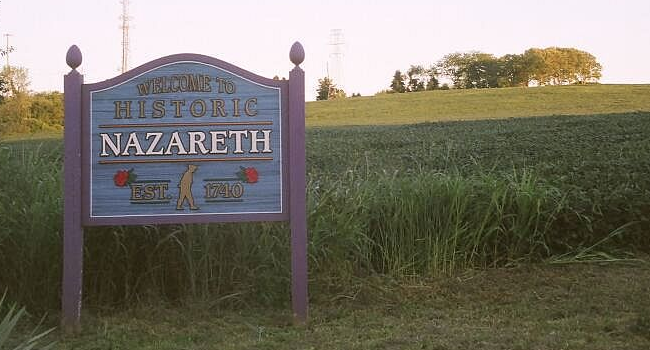The Moore Township Zoning Hearing Board met Wednesday, August 17 to continue the Water’s Edge at Wind Gap LLC Industrial Development for Warehouse Use property proposal appeal of the zoning officer’s determinations. The appeal challenges the substantive validity of various sections of the township’s zoning ordinance and zoning officer determinations.
Township Solicitor David Backenstoe began the hearing with a cross-examination of Stephen M. Walsh from Dynamic Engineering Consultants.
Backenstoe pointed out that per the zoning ordinance, man-made slopes and steep slopes within previously disturbed areas are not exempt from preservation requirements. Steep slopes are defined as areas of 3,000 square feet or greater which have a slope greater than 8% and are subject to higher rates of stormwater runoff and therefore erosion.
Walsh agreed with Backenstoe that the classification of steep slopes is not determined by origin of the slope and that there is no exception for man-made slopes in the zoning ordinance. Based on this ordinance, Walsh identified that the man-made steep slopes cause a hardship for the development of the property. Backenstoe established that the applicant filed an interpretation regarding steep slopes on the property rather than a variance.
Additionally, Backenstoe identified that the applicants did not show the varying grades of steep slopes on the entire plan, which is a requirement. However, Walsh explained that the areas of the plan where the steep slopes are not shown with their respective grades are due to being man-made steep slopes created by the golf course and do not relate to the applicant’s project area.
Backenstoe asked Walsh, “Would you agree with me that prior disturbance of the natural resource does not make the resource unnatural?”
Walsh responded, “I would say that the ordinance was intended to protect currently natural resources, not the current conditions, which is developed.”
Backenstoe rebutted that man-made slopes are also regulated by the township, but Walsh stated that he did not believe this to be the case for this development because the developer is planning to flatten the steep slopes for the construction of the warehouses.
Next, Backenstoe referred to Walsh’s testimony that the township is requiring off-site improvements and asked how the township’s request for the applicant to perform a Transportation Impact Study at additional intersections outside the scope of two miles due to the nature and magnitude of the project, including Route 512 and Route 248, is asking for off-site improvements.
Walsh expressed that the ordinance is not asking for improvements, but a review of their case law indicates they may be responsible for improvements to these intersections depending on the results of the traffic study.
However, Backenstoe stated that any improvements required to these intersections would be required by PennDOT, not the township. Additionally, the applicant did not schedule a scoping meeting with township staff, the township engineer, and representatives of PennDOT to establish the scope of the traffic study to comply with the ordinance.
Next, Backenstoe brought up the applicant’s request to forgo installing the required berm in favor of protecting the woodlands on the property. Backenstoe proposed that the applicant could place the berm behind the woodlands to comply with both, which was also the determination made by the township engineer.
Walsh expressed that this presents an undue hardship because it doubles the requirement for the front yard, and they are seeking relief to maintain the existing vegetation in place of the berm.
Backenstoe then referred to Walsh’s testimony alleging that the zoning officer determined the applicant failed to comply with required parking spaces and staging or queuing spaces in the preliminary plan. However, Backenstoe pointed out that the township engineer and zoning officer did not make any determinations regarding parking and loading at this time.
Backenstoe asked Walsh whether a memo was provided to the township engineer regarding explanations for the questions that the township engineer asked in the Keystone Consulting Engineers review letter dated January 24.
Walsh responded that a memo was not issued to the township engineer before the zoning appeal was filed, but that the applicant provided answers during the July 6 appeal presentation.
Backenstoe asked Walsh why they are filing for relief if they can comply with both provisions, which they admitted they can do.
Walsh expressed their understanding was the township engineer’s determinization was that the plan did not comply, which is why they were asking for an interpretation.
Next, Backenstoe brought up vehicular access to Jones Road, which is for emergency services only, and asked whether the applicant will be making improvements to Jones Road for ingress and egress to the site.
Walsh stated they have proposed performing a realignment but are challenging the extent of the improvements because they do not believe improvements should be required since the access point is for emergency services only.
Board Solicitor Chad DiFelice asked what impact the warehouses would have on Route 946 or traffic traveling to Route 33 or Route 248.
Walsh stated, “We are not fully through the impact study.”
Attorney Kaplin added that PennDOT has their own set of regulations and if any off-site intersections are affected, PennDOT will determine what mitigations will be required by the applicant.
Next, Solicitor Backenstoe called Horvath as a witness, establishing him as an expert in engineering and township land development and subdivision plans.
Backenstoe called attention to the illumination levels in the engineer’s review letter, which stated: “All driveways, aisles, and maneuvering spaces shall be adequately illuminated during nighttime hours of use. Proposed illumination levels are deficient within portions of parking, loading, and staging areas and drive aisles.”
Horvath stated that the land development plans have three spots where there is no lighting in passenger vehicle and truck storage or queuing areas.
Backenstoe then asked Horvath about the importance of the identification of steep slopes by their grade to determine the magnitude of the slopes and determine the magnitude if those slopes are disturbed and the conflict between the zoning ordinance and the SALDO. It was determined that provisions in the subdivision and land development varying of design standards shall not be considered to be in conflict with the provisions of this ordinance which shall take precedence, as provided by subsection 200-4-D of the township Zoning Ordinance.
Horvath also provided testimony that Jones Road does not meet current standards, which triggers improvements that will need to be made to Jones Road by the applicant.
Due to the length of the meeting, Kaplin will be able to cross-examine Horvath at the next meeting, which will reconvene on Wednesday, September 21 at 6 p.m. in the Moore Elementary School cafeteria, located at 2835 Mountain View Dr., Bath.








